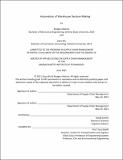| dc.description.abstract | This capstone addresses how an FMCG company should go about automating inbound decision making in one of their warehouses. The capstone focuses only on the inbound side of the distribution center because it was determined that it was an area with big opportunities for improvement. Efficiency inside a warehouse depends greatly on the correct decisions being made. Currently, the decisions being made inside the sponsor’s warehouse are not consistent because they vary between shifts, and it is hard to make the correct decision because there are many variables that must be considered. To address this problem, this research project developed a simulation model that replicates the current inbound state of the warehouse. The model was used to create and compare different scenarios and unloading policies. For example, it was found that the prioritization of trucks that are more time-consuming to process in some cases has an impact on overall drop-lot waiting time. The project shows how the unloading policies affect the average waiting time of trucks. Replicating this process for all the decisions led to determining what are the best policies for what scenarios. | en_US |
